Consolidation Reference Manual
You can still refer to the Consolidation reference manual for consolidation information that has not been impacted by changes in the legislation.
C10 MEC groups
C10-2 Worked example
Formation and conversion
C10-2-115 Original and new eligible tier-1 companies of a MEC group
Description
This example explains the differences between 'original' and 'new' eligible tier-1 companies and how those differences apply when a MEC group expands or a MEC group is created from a consolidated group. A MEC group may expand when it (or its top company) acquires another MEC group, a consolidated group or new eligible tier-1 companies. Note that only the provisional head company of the acquiring group can make the choice to expand. The acquired group cannot choose to expand.
Commentary
Broadly, original eligible tier-1 companies of a MEC group are those eligible tier-1 companies that:
- •
- were party to the choice to form the MEC group and have continued to be eligible tier-1 companies of the top company since that formation, or
- •
- joined at the time when a MEC group was created from a consolidated group under the special conversion event rules and have continued to be eligible tier-1 companies of the top company since that creation.
In the second situation, the head company of the consolidated group would be an original eligible tier-1 company of the MEC group created from the consolidated group.
→ 'Group conversions', C10-1-210
Example 1
Original eligible tier-1 companies when a MEC group forms by choice
In Figure 1, ACo, BCo, and CCo are eligible tier-1 companies of the top company XCo. UCo is an unrelated Australian-resident company. ACo and BCo have chosen to form a MEC group, but CCo has not chosen to be part of the MEC group.
Figure 1: MEC group formed by choice
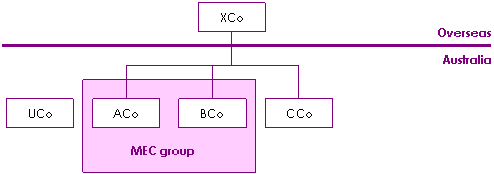
ACo and BCo are original eligible tier-1 members of the MEC group. CCo cannot later join this MEC group as a new eligible tier-1 member because it did not become an eligible tier-1 company of the top company after the group formed. Nor can CCo join the MEC group if the group expands as a consequence of new eligible tier-1 companies becoming members of the group.
Example 2
Original eligible tier-1 members after a special conversion event
In Figure 2, HCo is the head company of a consolidated group formed with its wholly-owned subsidiary SCo. HCo is the wholly owned Australian-resident subsidiary of the foreign parent, ZCo.
Figure 2: MEC group from a consolidated group (special conversion event)
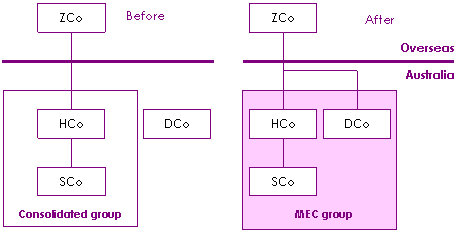
HCo is also an eligible tier-1 company of a potential MEC group with ZCo as its top company.
DCo is an unrelated Australian-resident company.
If ZCo acquires all the membership interests in DCo, the latter would also become an eligible tier-1 company of ZCo. HCo, as the head company of the consolidated group, can make a choice in writing that DCo is to become a member of the group, and as a result a MEC group is created at that time (the conversion time). This is known as a special conversion event. At the conversion time, HCo's consolidated group ceases to exist and HCo's MEC group comes into existence. Both HCo and DCo will be original eligible tier-1 members of the MEC group.
→ 'Choice in writing', C7-1-110 ; 'Group conversions', C10-1-210
Example 3
New eligible tier-1 members of a MEC group
Broadly, new eligible tier-1 members of a MEC group are companies that become eligible tier-1 companies of the top company, and members of the MEC group, after the group has formed. Figure 3 shows how this might apply to the companies described in example 1.
Figure 3: New eligible tier-1 companies of a MEC group
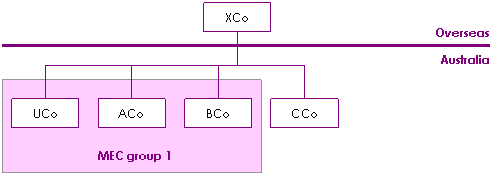
XCo acquires all the membership interests in UCo, and UCo becomes an eligible tier-1 company of XCo. ACo, the provisional head company, makes a choice in writing that UCo is to become a member of the MEC group. UCo will be a new eligible tier-1 member of the MEC group.
→ 'Choice in writing', C7-1-110
CCo can never become a new eligible tier-1 member of the MEC group formed by ACo and BCo, because it did not become an eligible tier-1 company of the top company after the MEC group formed.
Example 4
When a new top company has no consolidated or MEC groups
When the top company of a MEC group is taken over by a new top company whose Australian subsidiaries have not formed either consolidated groups or MEC groups, a number of outcomes are possible.
Figure 4: The new top company has no MEC or consolidated groups
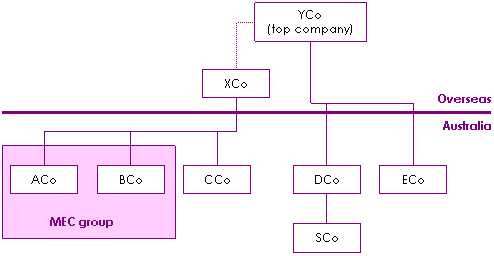
The following information is known about the companies in Figure 4:
- •
- ACo, BCo and CCo are all eligible tier-1 companies of top company XCo.
- •
- ACo and BCo have chosen to form a MEC group, while CCo has not chosen to be part of the MEC group.
- •
- DCo and ECo are eligible tier-1 companies of top company YCo.
- •
- SCo is a wholly-owned subsidiary of DCo.
- •
- DCo and ECo have not formed a MEC group.
- •
- DCo and SCo have not formed a consolidated group.
After the MEC group is formed, YCo takes over XCo and becomes the new top company of the MEC group formed by ACo and BCo. This MEC group continues with ACo and BCo as original eligible tier-1 members. DCo, ECo and SCo are not members of a MEC group or a consolidated group at the time of YCo taking over XCo so there cannot be an expansion of a MEC group.
CCo cannot join ACo and BCo's MEC group as an eligible tier-1 member, because CCo did not become an eligible tier-1 company of the top company, YCo, after the MEC group formed. DCo and ECo cannot join as eligible tier-1 members either because they are not new eligible tier-1 companies with respect to YCo, the top company for the MEC group.
Possible outcomes include:
- •
- DCo and ECo can form a MEC group (they will be original eligible tier-1 members of that potential MEC group)
- •
- DCo and SCo can form a consolidated group
- •
- DCo and ECo can remain unconsolidated
- •
- CCo can either join with DCo and ECo if they form a MEC group, or
- •
- either DCo or ECo can join with CCo to form a MEC group.
Example 5
When the new top company has MEC groups or consolidated groups
When the top company of a MEC group is taken over by another company that already has MEC groups or consolidated groups in Australia, a number of outcomes are possible.
Figure 5: The new top company has MEC or consolidated groups
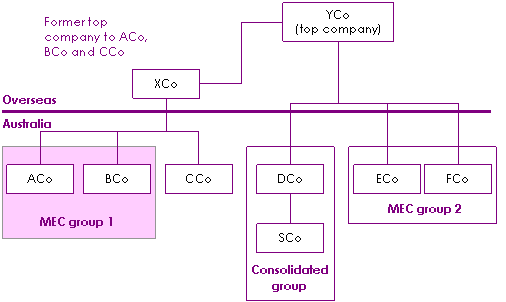
The following information is known about the companies in Figure 5:
- •
- ACo, BCo and CCo are eligible tier-1 companies of top company XCo.
- •
- ACo and BCo have chosen to form MEC group 1, with ACo as provisional head company. CCo did not choose to consolidate.
- •
- DCo, ECo and FCo are eligible tier-1 companies of top company YCo.
- •
- SCo is a wholly-owned subsidiary of DCo.
- •
- DCo (as head company) has formed a consolidated group with SCo.
- •
- ECo and FCo have formed MEC group 2, with ECo as provisional head company.
After the groups have formed, YCo takes over XCo and becomes the top company of MEC group 1 formed by ACo and BCo.
Possible outcomes include:
- •
- MEC group 1, MEC group 2, Consolidated group and CCo remain as they were before the restructure.
- •
- DCo could make a choice for:
- -
- ACo and BCo only
- -
- CCo only, or
- -
- ACo, BCo and CCo
- to become members of DCo's group. If DCo makes any of these choices, a MEC group will be created from DCo's consolidated group. Depending on which choice DCo makes, DCo and the other eligible tier-1 companies who join the group will be original eligible tier-1 members of the MEC group created from the consolidated group.
- •
- MEC group 2 could expand if its provisional head company, ECo, chooses to include:
- -
- ACo and BCo only
- -
- CCo only, or
- -
- ACo, BCo and CCo
- as members of MEC group 2. ECo together with FCo will be original eligible tier-1 members. And, depending on which choice ECo makes, the other eligible tier-1 companies who join the group will be new eligible tier-1 members of the expanded MEC group.
Only provisional head companies or head companies of an acquiring group can choose to expand their groups. In this case, ACo and ECo are the provisional head companies of MEC group 1 and MEC group 2 respectively, and DCo is the head company of the consolidated group. Because YCo acquires XCo, the head company and provisional head company of the 'acquiring' groups, DCo and ECo respectively, are able to expand their respective groups by including ACo, BCo and CCo from the 'acquired' group.
Note that, because ACo and BCo are members of a MEC group, both must be included in the MEC group created from the consolidated group or the expanded MEC group.
References
Income Tax Assessment Act 1997 , Division 719 as amended by New Business Tax System (Consolidation) Act (No. 1) 2002 (No. 68 of 2002), Schedule 1
Income Tax Assessment Act 1997 , Division 719 as amended by New Business Tax System (Consolidation and Other Measures) Act (No. 1) 2002 (No. 117 of 2002), Schedule 8
Explanatory Memorandum to the New Business Tax System (Consolidation) Bill (No. 1) 2002, Chapter 4
Explanatory Memorandum to the New Business Tax System (Consolidation and Other Measures) Bill (No. 1) 2002, Chapter 8, paragraphs 19 to 23
Income Tax Assessment Act 1997 , Subdivision 719-BA as inserted by Tax Laws Amendment (2010 Measures No. 1) Act 2010 ( No. 56 of 2010) Schedule 5, Part 2
Explanatory Memorandum to the Tax Laws Amendment (2010 Measures No. 1) Bill 2010, Chapter 5, paragraphs 5.65 to 5.100 and 5.105 to 5.108
History
Revision history
Section C10-2-115 first published 28 May 2003.
Further revisions are described below.
| Date | Amendment | Reason |
|---|---|---|
| 26.10.05 | Editorial changes. | For clarification. |
| 6.5.11 | Significant revisions to reflect changes to the choice provisions and group conversions. | Legislative amendments. |
Current at 6 May 2011
